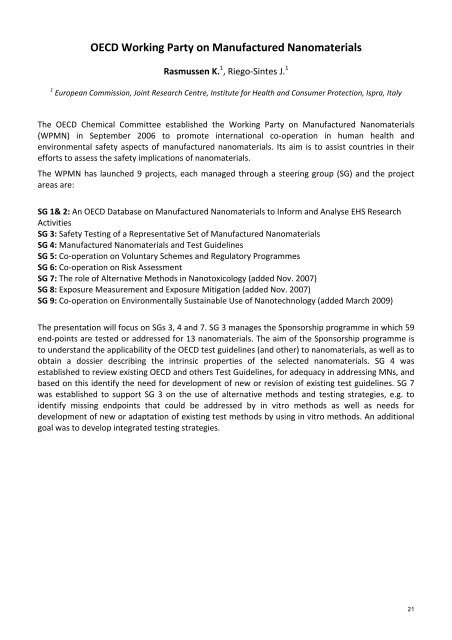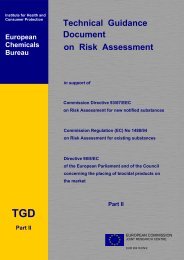Challenges of Regulation and Risk Assessment of Nanomaterials
Challenges of Regulation and Risk Assessment of Nanomaterials
Challenges of Regulation and Risk Assessment of Nanomaterials
Create successful ePaper yourself
Turn your PDF publications into a flip-book with our unique Google optimized e-Paper software.
OECD Working Party on Manufactured <strong>Nanomaterials</strong><br />
Rasmussen K. 1 , Riego-Sintes J. 1<br />
1 European Commission, Joint Research Centre, Institute for Health <strong>and</strong> Consumer Protection, Ispra, Italy<br />
The OECD Chemical Committee established the Working Party on Manufactured <strong>Nanomaterials</strong><br />
(WPMN) in September 2006 to promote international co-operation in human health <strong>and</strong><br />
environmental safety aspects <strong>of</strong> manufactured nanomaterials. Its aim is to assist countries in their<br />
efforts to assess the safety implications <strong>of</strong> nanomaterials.<br />
The WPMN has launched 9 projects, each managed through a steering group (SG) <strong>and</strong> the project<br />
areas are:<br />
SG 1& 2: An OECD Database on Manufactured <strong>Nanomaterials</strong> to Inform <strong>and</strong> Analyse EHS Research<br />
Activities<br />
SG 3: Safety Testing <strong>of</strong> a Representative Set <strong>of</strong> Manufactured <strong>Nanomaterials</strong><br />
SG 4: Manufactured <strong>Nanomaterials</strong> <strong>and</strong> Test Guidelines<br />
SG 5: Co-operation on Voluntary Schemes <strong>and</strong> Regulatory Programmes<br />
SG 6: Co-operation on <strong>Risk</strong> <strong>Assessment</strong><br />
SG 7: The role <strong>of</strong> Alternative Methods in Nanotoxicology (added Nov. 2007)<br />
SG 8: Exposure Measurement <strong>and</strong> Exposure Mitigation (added Nov. 2007)<br />
SG 9: Co-operation on Environmentally Sustainable Use <strong>of</strong> Nanotechnology (added March 2009)<br />
The presentation will focus on SGs 3, 4 <strong>and</strong> 7. SG 3 manages the Sponsorship programme in which 59<br />
end-points are tested or addressed for 13 nanomaterials. The aim <strong>of</strong> the Sponsorship programme is<br />
to underst<strong>and</strong> the applicability <strong>of</strong> the OECD test guidelines (<strong>and</strong> other) to nanomaterials, as well as to<br />
obtain a dossier describing the intrinsic properties <strong>of</strong> the selected nanomaterials. SG 4 was<br />
established to review existing OECD <strong>and</strong> others Test Guidelines, for adequacy in addressing MNs, <strong>and</strong><br />
based on this identify the need for development <strong>of</strong> new or revision <strong>of</strong> existing test guidelines. SG 7<br />
was established to support SG 3 on the use <strong>of</strong> alternative methods <strong>and</strong> testing strategies, e.g. to<br />
identify missing endpoints that could be addressed by in vitro methods as well as needs for<br />
development <strong>of</strong> new or adaptation <strong>of</strong> existing test methods by using in vitro methods. An additional<br />
goal was to develop integrated testing strategies.<br />
21








